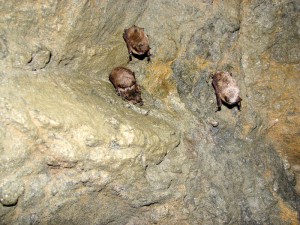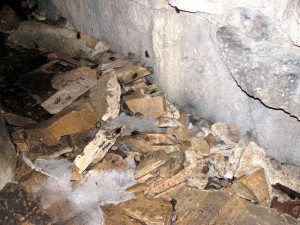On February 16, 2006, a recreational caver exploring Howes Cave in Albany, New York, photographed a bat with an unusual white growth on its muzzle. In the few years since that picture was snapped, hundreds of thousands of bats in North America have died from White-Nose Syndrome (WNS; 1,2).
The disease affects hibernating populations of bats, and has been found in the northeastern and eastern United States, as far south as Tennessee, as well as in the Canadian provinces of Quebec and Ontario (2).
Some suffering bats are emaciated with little or no body fat and have a characteristic white fungal growth on their wing membranes, ears and muzzles, hence the name “White-Nose Syndrome.” Instead of hibernating all winter, these bats can be seen active in the snow, when there is virtually no food available for them (1,2).
The white fungal growth observed on the bats is the result of infection with a previously undescribed cold-loving fungus,
which has been identified as a new species within the Geomyces genus, Geomyces destructans (1,3; note added in 2016: this fungus is now called Pseudogymnoascus destructans). Analysis of G. destructans samples suggests that the bats have been infected with G. destructans originating from a single source (3).
So far, according to Dr. David Blehert at the United States Geological Survey (USGS) – National Wildlife Health Center, no data indicate that there is any other etiologic agent at play here. G. destructans is the primary suspect.
G. destructans has been found on hibernating bats in caves in Germany, France, Hungary, and Switzerland. However the affected bats in Europe are not emaciated, and those affected bats that were tracked after the initial isolation remained healthy (4).
As far as scientists can tell, the European and North American isolates of G. destructans are the same; however, the G. destructans type strain (U.S. isolate) was just sequenced by the Eli and Edythe L Broad Institute of Harvard and MIT, and a resequencing study is underway in collaboration with Paul Keim’s laboratory group at Northern Arizona University to compare the genomes of the US and European isolates. Such a comparison will allow researchers to determine if the US isolate of the fungus has any particular virulence factors that would make it more invasive (D. Blehert, personal communication).
If the US and European isolates of G. destructans are genetically identical, then understanding why North American bat populations are decimated by the fungus while European populations are not becomes more difficult. It is possible that the European bats have developed resistance to invasive infection with the fungus because they co-evolved with it. Understanding the nature of that resistance may or may not help researchers develop a strategy for saving the US populations (2, 4).
An alternative approach would be to treat the U.S. bats pharmacologically. However, fungal infections are notoriously difficult to treat, and any chemical given to bats will be metabolized and excreted by them into the delicate ecosystem of the cave. Ensuring that those metabolites do not harm other ecologically important cave fauna is essential.
For now, the focus is prevention, keeping the WNS from spreading to unaffected areas in North America. But, how do you keep a fungus from spreading among a population of densely packed, small mammals in tiny, cold damp areas (a fungal haven)?
USGS researchers are trying to determine if any other animal species can be infected with the fungus or serve as vectors for the fungus. Fungi closely related to G. destructans have been isolated from soil, animal fur, floors of trains and ferry boats and even from environmental samples in the Arctic. If G. destructans has the same potential for wide distribution, then virtually any animal or human could transport it from place to place. Right now, caution is the better part of virtue, a voluntary moratorium on caving until we know more may go a long way to helping curb this outbreak. The other key is an informed public; bats aren’t supposed to be active in the winter. So, if you see bats staggering around in the snow, visit the WNS page of the USGS web site (http://www.nwhc.usgs.gov/disease_information/white-nose_syndrome/) and contact one of their biologists. (Do not handle the bat yourself; bats can be vectors for rabies.)
Bats are key species in forest and cave ecosystems. They are plant pollinators and consume a significant volume of nighttime insects. Additionally bats bring nutrients into the relatively isolated ecosystems of caves. It may be that Nature will have to restore a new balance to the cave ecosystems, and only time will tell what that balance will look like. One thing is certain, with a 75% decline in bat populations over a two-year period, that new balance will look very different from the old one.
References
- Blehert, D. et al. (2009) Bat White-Nose Syndrome: An Emerging Fungal Pathogen? Science 323, 227.
- National Wildlife Health Center. White Nose Syndrome. [Internet] United States Geological Survey. Accessed: 28 October 2010. http://www.nwhc.usgs.gov/disease_information/white-nose_syndrome/
- Chaturvedi, V. et al. (2010) Morphological and Molecular Characterizations of Psychrophilic Fungus Geomyces destructans from New York Bats with White Nose Syndrome (WNS) PLoS ONE 5, e10783.
- Wibbelt, G. et al. (2010) White-Nose Syndrome Fungus (Geomyces destructans) in Bats, Europe. Emerging Infectious Diseases 16, 1237-42.
Acknowledgment
Many thanks to D. Blehert at the USGS for his time and assistance.


